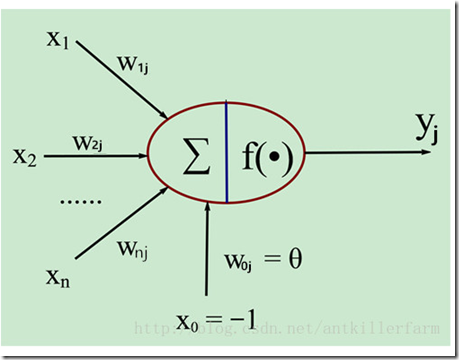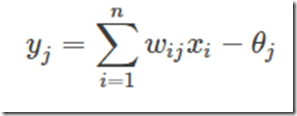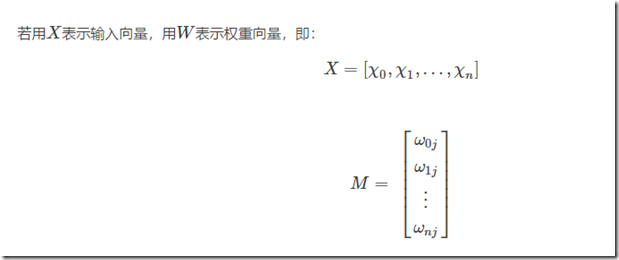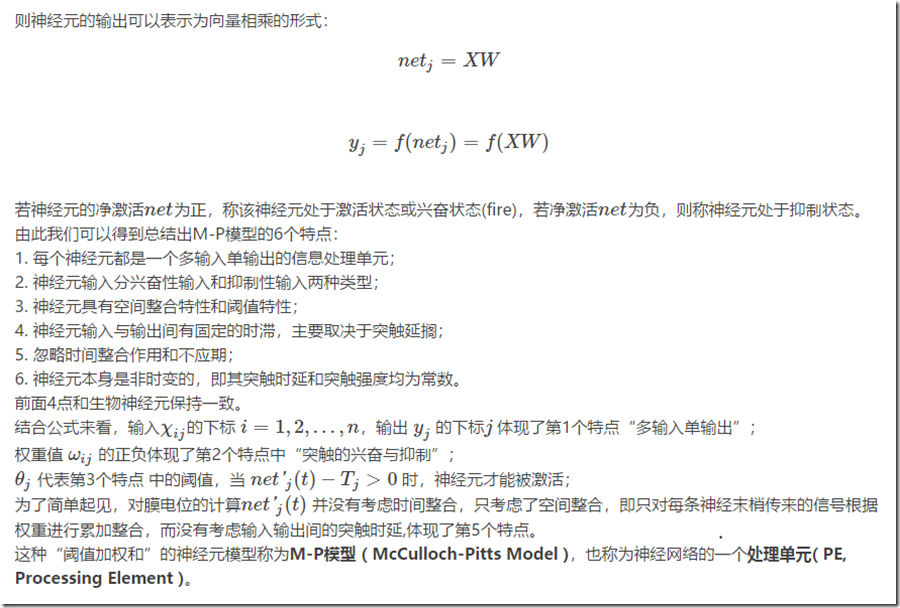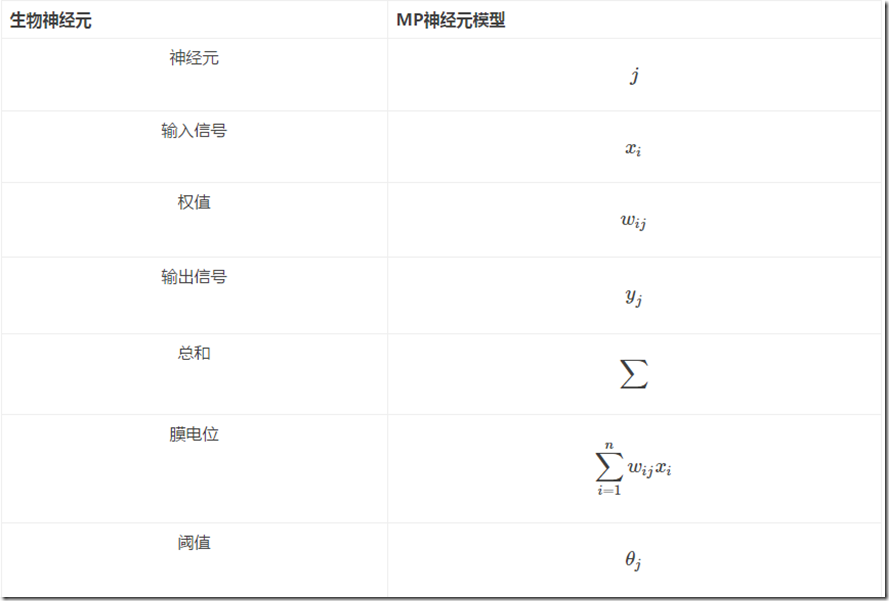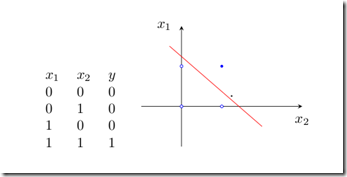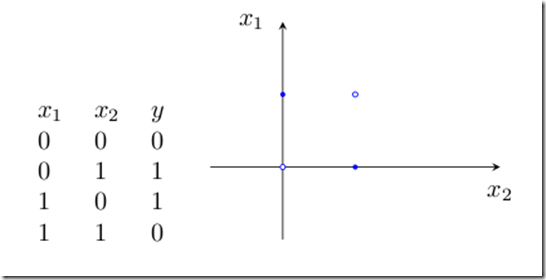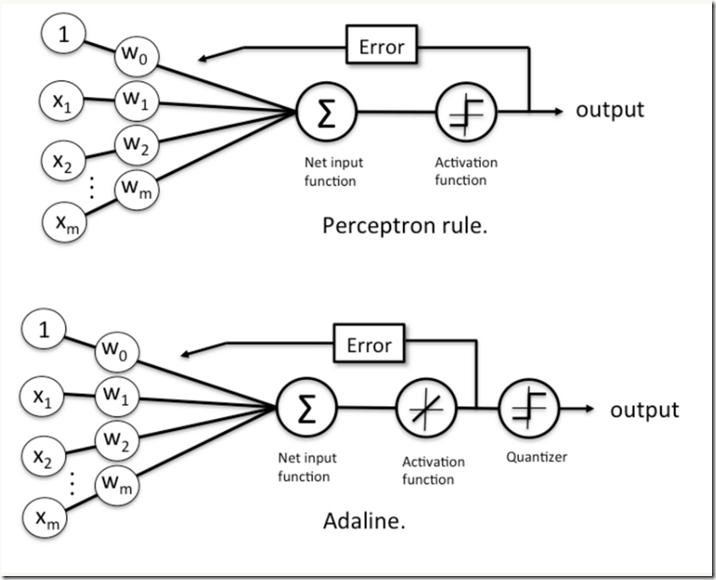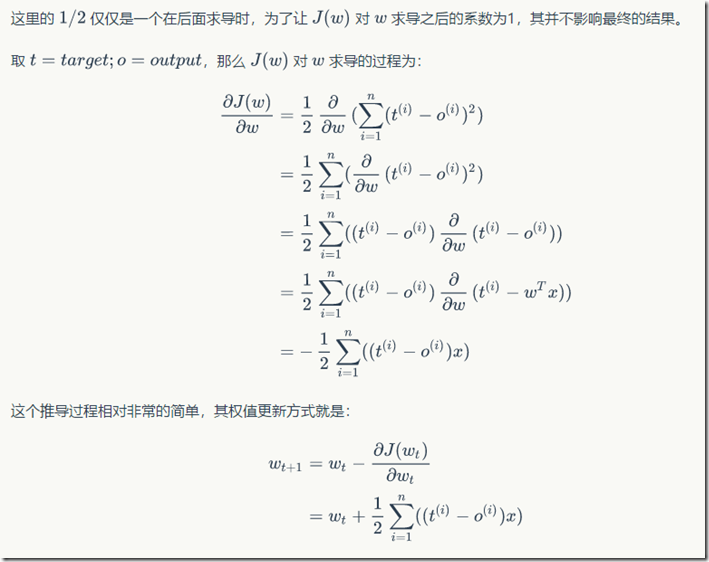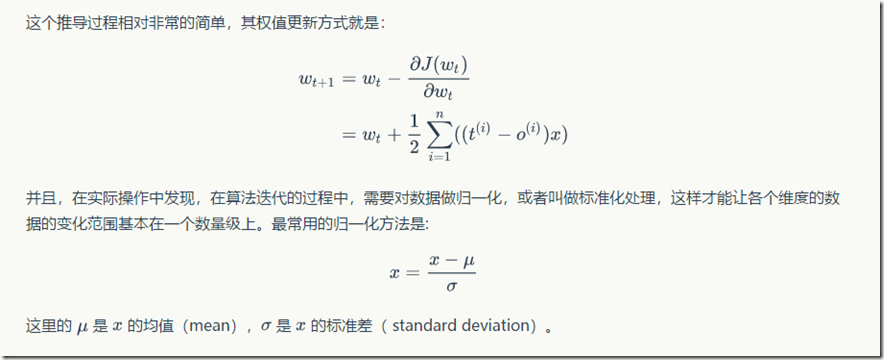机器学习分类算法
本章将介绍最早以算法方式描述的分类机器学习算法:感知器(perceptron)和自适应线性神经元。
人造神经元——早期机器学习概览
MP神经元
生物神经元和MP神经元模型的对应关系如下表:
这个结构非常简单,如果你还记得前面所讲的M-P神经元的结构的话,这个图其实就是输入输出两层神经元之间的简单连接
单层感知器的局限性
虽然单层感知器简单而优雅,但它显然不够聪明——它仅对线性问题具有分类能力。什么是线性问题呢?简单来讲,就是用一条直线可分的图形。比如,逻辑“与”和逻辑“或”就是线性问题,我们可以用一条直线来分隔0和1。
1)逻辑“与”的真值表和二维样本图如图2:
2)逻辑“或”的真值表如图3:
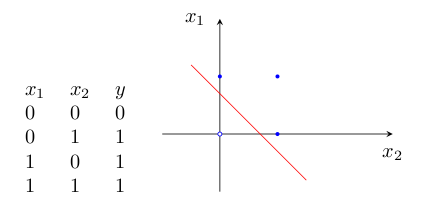
为什么感知器就可以解决线性问题呢?这是由它的传递函数决定的。这里以两个输入分量 x1 和 x2 组成的二维空间为例,此时节点 j 的输出为
所以,方程
确定的直线就是二维输入样本空间上的一条分界线。对于三维及更高维数的推导过程可以参考其他的Tutorials。
如果要让它来处理非线性的问题,单层感知器网就无能为力了。例如下面的“异或”,就无法用一条直线来分割开来,因此单层感知器网就没办法实现“异或”的功能。
使用Python 实现感知器学习算法
Perceptron.py
import numpy as np #eta是学习率 n_iter是迭代次数 #errors_是每个阶段的错误数 #w_是权重吧 class Percetron(object): def __init__(self,eta=0.01,n_iter=10): self.eta=eta self.n_iter=n_iter def fit(self,X,y): self.w_=np.zeros(1+X.shape[1])#X的列数+1 self.errors_=[] for _ in range(self.n_iter):#迭代次数 errors=0 for xi,target in zip(X,y):#将X,y组成 update=self.eta*(target-self.predict(xi))#预测目标和实际目标是否相同 self.w_[1:]+=update*xi#更新 self.w_[0]+=update#更新b errors+=int(update != 0.0)#记录这次迭代的错误数 self.errors_.append(errors) return self#关键返回参数W def net_input(self,X):#输入X,输出结果 return np.dot(X,self.w_[1:])+self.w_[0] def predict(self,X): return np.where(self.net_input(X)>=0.0,1,-1)#如果结果大于等于0,返回1,否则返回0
main.py
import pandas as pd import matplotlib.pyplot as plt import numpy as np import Percetron as P from matplotlib.colors import ListedColormap def plot_decision_regions(X,y,classifier,resolution=0.02):#绘制决策边界 markers=('s','x','o','^','v')#标记 colors=('red','blue','lightgreen','gray','cyan')#颜色 cmap=ListedColormap(colors[:len(np.unique(y))])#定义一些颜色和标记符号,并通过颜色列表生成了颜色示例图 x1_min,x1_max=X[:,0].min()-1,X[:,0].max()+1#对最大值和最小值做出限定 x2_min,x2_max=X[:,1].min()-1,X[:,1].max()+1 xx1,xx2=np.meshgrid(np.arange(x1_min,x1_max,resolution),np.arange(x2_min,x2_max,resolution)) Z=classifier.predict(np.array([xx1.ravel(),xx2.ravel()]).T) z=Z.reshape(xx1.shape) plt.xlim(xx1.min(),xx1.max())#x轴范围 plt.ylim(xx2.min(),xx2.max())#y轴范围 for idx,c1 in enumerate(np.unique(y)): plt.scatter(x=X[y==c1,0],y=X[y==c1,1],alpha=0.8,c=cmap(idx),marker=markers[idx],label=c1) if __name__ == "__main__": df = pd.read_csv('https://archive.ics.uci.edu/ml/machine-learning-databases/iris/iris.data', header=None) df.tail() # 用于显示数据的最后五行以确保加载成功 y=df.iloc[0:100,4].values#此时y是类别名称 y=np.where(y=='Iris-setosa',-1,1)#若是这个名称则为-1,不是则为1 X=df.iloc[0:100,[0,2]].values#从表中获得X plt.scatter(X[:50,0],X[:50,1],color='red',marker='o',label='setosa') plt.scatter(X[50:100,0],X[50:100,1],color='blue',marker='x',label='versicolor') plt.xlabel('petal length') plt.ylabel('sepal length') plt.legend(loc='upper left') plt.show() ppn=P.Percetron(eta=0.1,n_iter=10)#初始化感知器 ppn.fit(X,y)#拟合感知器 plt.plot(range(1,len(ppn.errors_)+1),ppn.errors_,marker='o')#横坐标从1到len(errors_),纵坐标为errors_, plt.xlabel('Epochs') plt.ylabel('Number of misclassifications') plt.show() plot_decision_regions(X,y,classifier=ppn) plt.xlabel('sepal length [cm]') plt.ylabel('petal length [cm]') plt.legend(loc='upper left') plt.show()
自适应线性神经元及其学习的收敛性
在之前的文章感知机中提到过,感知机分类器是一个非常好的二分类分类器。
但是感知机分类器仍然存在两个比较明显的缺陷:
- 感知机模型只能针对线性可分的数据集,对于非线性可分的数据集,无能为力
- 当两个类可由线性超平面分离时,感知器学习规则收敛,但当类无法由线性分类器完美分离
为了解决感知机的这两个主要的缺陷,就有了现在要讲的自适应线性神经元
在之前的感知机中,感知机的激活函数是阶跃函数,这里改为线性激活函数(linear activation function),一般来说,为了方便,可以直接取:
感知机框架和自适应线性神经元框架对比,注意,自适应线性神经元框架比感知机框架多了一个量化器(quantizer),其主要作用是得到样本的类别。
梯度下降法(Gradient Descent)
相对于阶跃函数而言,线性函数有一个明显的优点:函数是可微(differentiable)的。这就使得我们可以直接在这个函数上定义损失函数 J(W)(cost function),并对其进行优化。这里定义损失函数J(W)为平方损失误差和(SSE: sum of squared errors),这里假设训练样本集合的大小为n :
AdalineGD.py
import numpy as np import matplotlib.pyplot as plt import pandas as pd class AdalineGD(object): def __init__(self,eta=0.01,n_iter=50): self.eta=eta self.n_iter=n_iter def fit(self,X,y): self.w_=np.zeros(1+X.shape[1]) self.cost_=[] for i in range(self.n_iter): output=self.net_input(X) errors=(y-output) self.w_[1:]+=self.eta*X.T.dot(errors) self.w_[0]+=self.eta*errors.sum() cost=(errors**2).sum()/2 self.cost_.append(cost) return self def net_input(self,X): return np.dot(X,self.w_[1:])+self.w_[0] def activation(self,X): return self.net_input(X) def predict(self,X): return np.where(self.activation(X)>=0,1,-1) if __name__ == "__main__": df = pd.read_csv('https://archive.ics.uci.edu/ml/machine-learning-databases/iris/iris.data', header=None) df.tail() # 用于显示数据的最后五行以确保加载成功 y = df.iloc[0:100, 4].values # 此时y是类别名称 y = np.where(y == 'Iris-setosa', -1, 1) # 若是这个名称则为-1,不是则为1 X = df.iloc[0:100, [0, 2]].values # 从表中获得X fig,ax=plt.subplots(nrows=1,ncols=2,figsize=(8,4)) ada1=AdalineGD(n_iter=10,eta=0.01).fit(X,y) ax[0].plot(range(1,len(ada1.cost_)+1),np.log10(ada1.cost_),marker='o') ax[0].set_xlabel('Epochs') ax[0].set_ylabel('log(Sum-squared-error)') ax[0].set_title('Adaline-Learning rate 0.01') ada2=AdalineGD(n_iter=10,eta=0.0001).fit(X,y) ax[1].plot(range(1,len(ada2.cost_)+1),ada2.cost_,marker='o') ax[1].set_xlabel('Epochs') ax[1].set_ylabel('Sum-squared-error') ax[1].set_title('Adaline-Learning rate 0.0001') plt.show()
